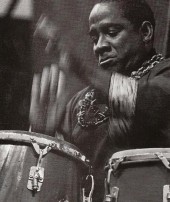Ramón Mongo Santamaria enjoyed a long and successful career in Latin music. His recordings and concert performances ranged from the authentic percussion music of Afro-Cuban religious rituals through to Latin-jazz reworkings of American jazz and pop hits.
His song Afro-Blue became a contemporary jazz standard, best-known in the coruscating version by saxophonist John Coltrane. In 1963, his own adaptation of Herbie Hancocks Watermelon Man provided the biggest hit of his career and was inducted into the Grammy Hall of Fame in 1998, Watermelon Man is regarded as a classic artefact on the Lounge Music scene.
He was born Ramon Santamaria in Havana, Cuba on April 7 of 1917, and nicknamed Mongo by his father (the word denotes a tribal chief in Senegal). He began learning violin, but quickly switched to drums and then congas, and left school early to work as a musician on the highly active local scene in Havana.
He graduated to the famous Tropicana Club with bands like Conjunto Matamoros and Conjunto Azul, then moved to New York in 1950. He was able to pursue his interest in American jazz at its epicentre, while gaining valuable exposure playing with two of the most important Latin band leaders in the city, Perez Prado and later Tito Puente.
Their explosive percussion battles became a major attraction in Puentes band, but in 1958 he left the band to work with the jazz vibraphonist Cal Tjader, who was beginning to explore the Latin jazz direction which made his reputation. He spent some years in California in this period, but returned to New York in 1962.
He was already making records under his own name while working with Tjader, and soon formed his own band in New York. He came across Herbie Hancocks Watermelon Man when the pianist sat in with the band at a Cuban music club in the Bronx in 1962, and immediately saw the possibilities. He also continued to work with the Fania All Stars.
His own version was a top ten entry on the American pop charts in 1963, and launched the percussionist on a new and more commercial direction, although the standard of his musicians generally remained high, including jazz artists like Chick Corea, Ray Vega, Sonny Fortune and Hubert Laws.
He pursued the strategy of adding a Latin groove to jazz and pop tunes throughout the next two decades, and became an acknowledged leader in the highly popular Latin-soul fusion movement of the era. He became one of the best known names in Latin music, and reached a wide audience with his accessible, dance-oriented approach to the music.
Although he never scored another hit of the magnitude of Watermelon Man, his other successes of the period included an energised version of La Bamba in 1964 and another big American success with his version of The Temptationss Cloud Nine in 1969. He received several Grammy nominations in the Seventies and Eighties, and won the award in 1977 for his album Amancer.
In the early Eighties he returned to a more jazz influenced direction. He continued to perform into the early Nineties, and made further recordings even after he retired from concert appearances.
Mongo Passed on February 1 of 2003
He is survived by his wife, Yolanda; six children, eight grandchildren, a great-grandchild and two sisters.
Thank you for visiting Mongo Santamarias Myspace fan page. If you know of any additional credits that should be posted, please feel free to message me. This tribute page has been created in loving memory of Mongo Santamaria.
